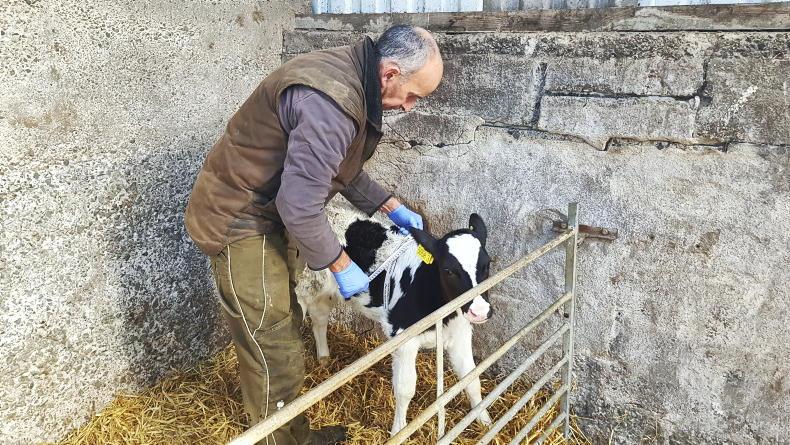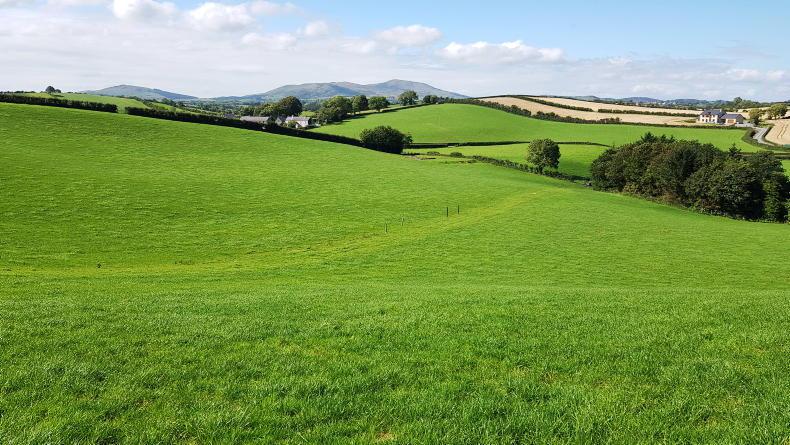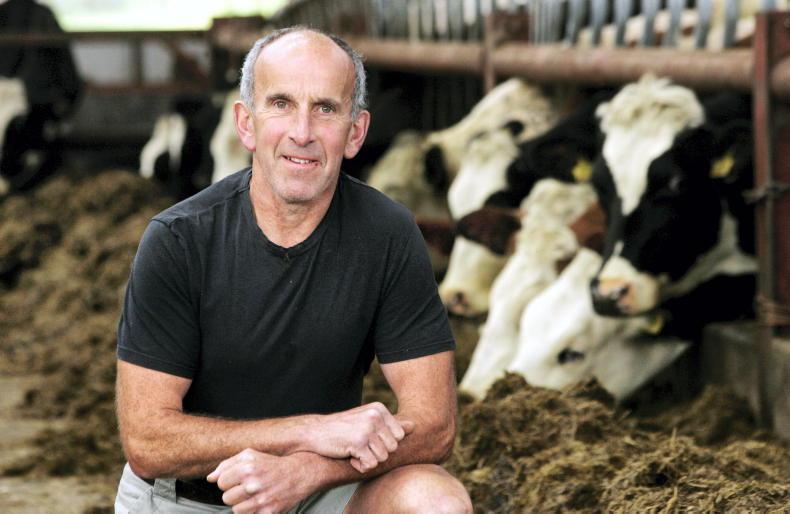The first of the autumn-calving cows are due to calve in mid-September on Hazel and Stephen Wallace’s farm at Seaforde, Co Down.
Tightening the calving spread has been a key objective of the Wallaces and one of their key reasons for joining the programme.
Work carried out on the farm has led to the calving pattern being tightened up significantly. Latest projections would suggest that around 95 % of animals in the herd will calve down between September and mid January this season.

Calving will kick off again in two weeks on the Wallace farm.
Stephen was busy this week, as cows continue to be dried off, with 12 cows due in the coming days. Cows are assessed for suitability for selective dry cow therapy at drying off time. His protocol is that any cow with SCC of less than 100,000 for the last three or four milk recordings is treated with teat sealant only. The rest of the herd receive dry cow antibiotics plus internal teat sealant.
The 50 cows that are closest to calving are eating specially made dry cow silage (made with no slurry or compound fertiliser) and are also getting 2kg/day of dry cow blend. The average body condition score of these cows is three and the first of these is expected to calve in mid-September.
The grazing platform at Heenendale Farm received 27 units/ac of CAN last week and 8ac were also taken out for bale silage as grass growth is strong.
The aftergrass will be grazed with calves.
Stephen reseeded 15ac back in spring and this was also cut for bale silage last week.

The Wallace farm has excellent natural resources - dry and fertile with 100ha in one block.
He plans to graze the aftergrass on these fields with ‘far-off’ dry cows up to three or four weeks before calving, when they will then be housed.
The fourth cut of silage, which was delayed due to the fact that part of that area was grazed because of poor grass growth rates in July/August, is still to be done.
Stephen hopes to get to this in the near future, but it still needs to bulk up a bit. He also intends to take out more area for reseeding, although it is getting late in the season.
Stephen is reviewing annual tonnages on the Agrinet programme to identify the lowest performing paddocks and will use the Pasture Production Index (PPI) to identify the most suitable varieties to sow.
As phase two of the Dairylink programme winds down, this virtual open day on the Wallace farm will review the journey that Stephen and Hazel have travelled.
One of the main objectives of the Dairylink programme is to improve the sustainability of the participating farms in terms of financial, environmental and social sustainability.
In the case of the Wallace farm, one of its key strengths is the fact that it is a large block (100ha) of relatively dry and free draining land. Making more use of this excellent resource has been a key priority.
Steps such as improving grass production and utilisation on the farm, as well as adopting measures to improve soil fertility and develop a nutrient management plan have all taken place. Stephen has also developed grass measuring and budget skills and his findings will be discussed at the webinar.
Initial soil analysis carried out on Heenandale Farm suggested that soil pH was an issue that needed to be addressed, as 64 % of the area sampled was below the optimum for grass growth (less than pH 6.1), while 17% and 15.5% of the area sampled was below optimum for soil P and K respectively. A nutrient management plan has been developed for the farm, based on soil analysis and crop need. Since then, almost 50ha have received 5-6t lime per hectare (2-2.5t lime per acre). In addition, fields that have been identified as being low in P (index less than 2+) and K (index less than 2-) have received additional nutrients through applications of slurry and inorganic fertiliser.
Current average levels of performance are 8,098l/cow/ year, with a corresponding milk solids yield of 619kg/cow/year. The average amount of concentrate being fed is 2,700kg/cow/year, while the current Margin Over Concentrate (MOC) is £1,718/cow/year.
The virtual open day will take place on Tuesday 7 September at 8pm on www.ifj.ie/webinar.
The first of the autumn-calving cows are due to calve in mid-September on Hazel and Stephen Wallace’s farm at Seaforde, Co Down.
Tightening the calving spread has been a key objective of the Wallaces and one of their key reasons for joining the programme.
Work carried out on the farm has led to the calving pattern being tightened up significantly. Latest projections would suggest that around 95 % of animals in the herd will calve down between September and mid January this season.

Calving will kick off again in two weeks on the Wallace farm.
Stephen was busy this week, as cows continue to be dried off, with 12 cows due in the coming days. Cows are assessed for suitability for selective dry cow therapy at drying off time. His protocol is that any cow with SCC of less than 100,000 for the last three or four milk recordings is treated with teat sealant only. The rest of the herd receive dry cow antibiotics plus internal teat sealant.
The 50 cows that are closest to calving are eating specially made dry cow silage (made with no slurry or compound fertiliser) and are also getting 2kg/day of dry cow blend. The average body condition score of these cows is three and the first of these is expected to calve in mid-September.
The grazing platform at Heenendale Farm received 27 units/ac of CAN last week and 8ac were also taken out for bale silage as grass growth is strong.
The aftergrass will be grazed with calves.
Stephen reseeded 15ac back in spring and this was also cut for bale silage last week.

The Wallace farm has excellent natural resources - dry and fertile with 100ha in one block.
He plans to graze the aftergrass on these fields with ‘far-off’ dry cows up to three or four weeks before calving, when they will then be housed.
The fourth cut of silage, which was delayed due to the fact that part of that area was grazed because of poor grass growth rates in July/August, is still to be done.
Stephen hopes to get to this in the near future, but it still needs to bulk up a bit. He also intends to take out more area for reseeding, although it is getting late in the season.
Stephen is reviewing annual tonnages on the Agrinet programme to identify the lowest performing paddocks and will use the Pasture Production Index (PPI) to identify the most suitable varieties to sow.
As phase two of the Dairylink programme winds down, this virtual open day on the Wallace farm will review the journey that Stephen and Hazel have travelled.
One of the main objectives of the Dairylink programme is to improve the sustainability of the participating farms in terms of financial, environmental and social sustainability.
In the case of the Wallace farm, one of its key strengths is the fact that it is a large block (100ha) of relatively dry and free draining land. Making more use of this excellent resource has been a key priority.
Steps such as improving grass production and utilisation on the farm, as well as adopting measures to improve soil fertility and develop a nutrient management plan have all taken place. Stephen has also developed grass measuring and budget skills and his findings will be discussed at the webinar.
Initial soil analysis carried out on Heenandale Farm suggested that soil pH was an issue that needed to be addressed, as 64 % of the area sampled was below the optimum for grass growth (less than pH 6.1), while 17% and 15.5% of the area sampled was below optimum for soil P and K respectively. A nutrient management plan has been developed for the farm, based on soil analysis and crop need. Since then, almost 50ha have received 5-6t lime per hectare (2-2.5t lime per acre). In addition, fields that have been identified as being low in P (index less than 2+) and K (index less than 2-) have received additional nutrients through applications of slurry and inorganic fertiliser.
Current average levels of performance are 8,098l/cow/ year, with a corresponding milk solids yield of 619kg/cow/year. The average amount of concentrate being fed is 2,700kg/cow/year, while the current Margin Over Concentrate (MOC) is £1,718/cow/year.
The virtual open day will take place on Tuesday 7 September at 8pm on www.ifj.ie/webinar.








 This is a subscriber-only article
This is a subscriber-only article










SHARING OPTIONS: